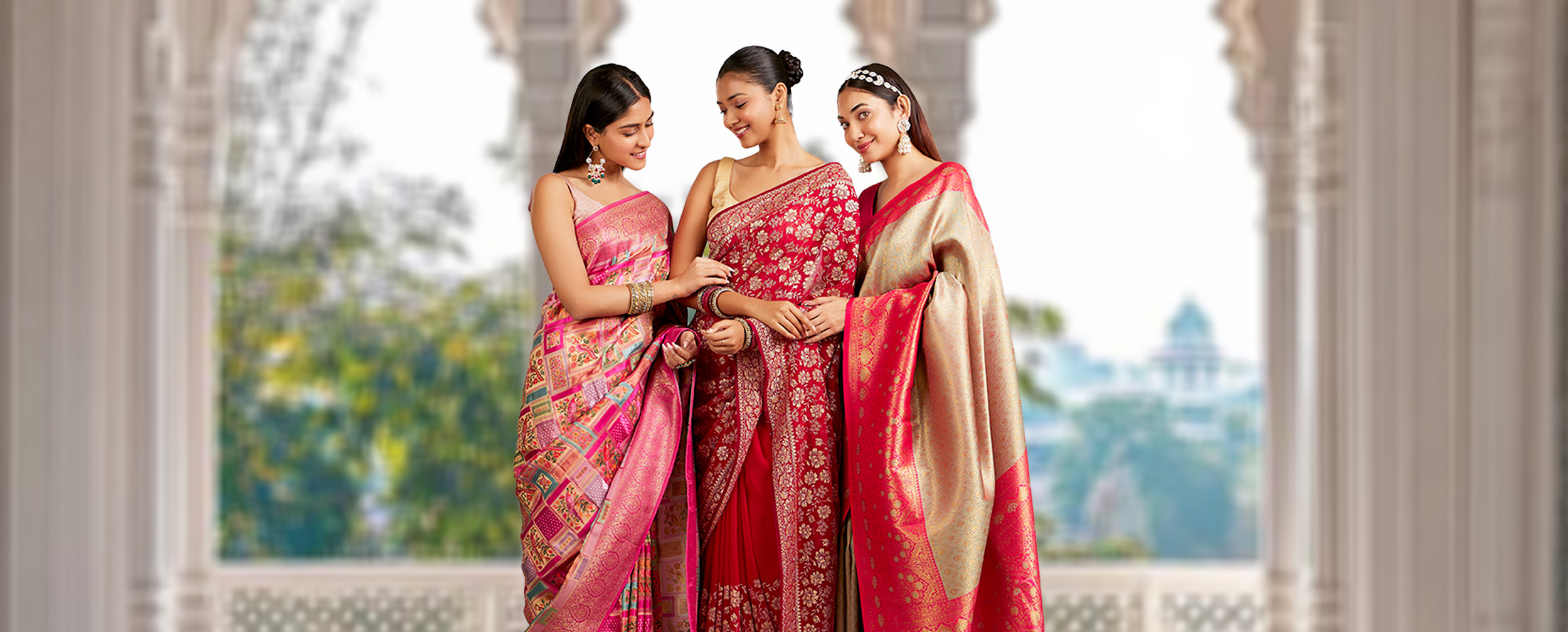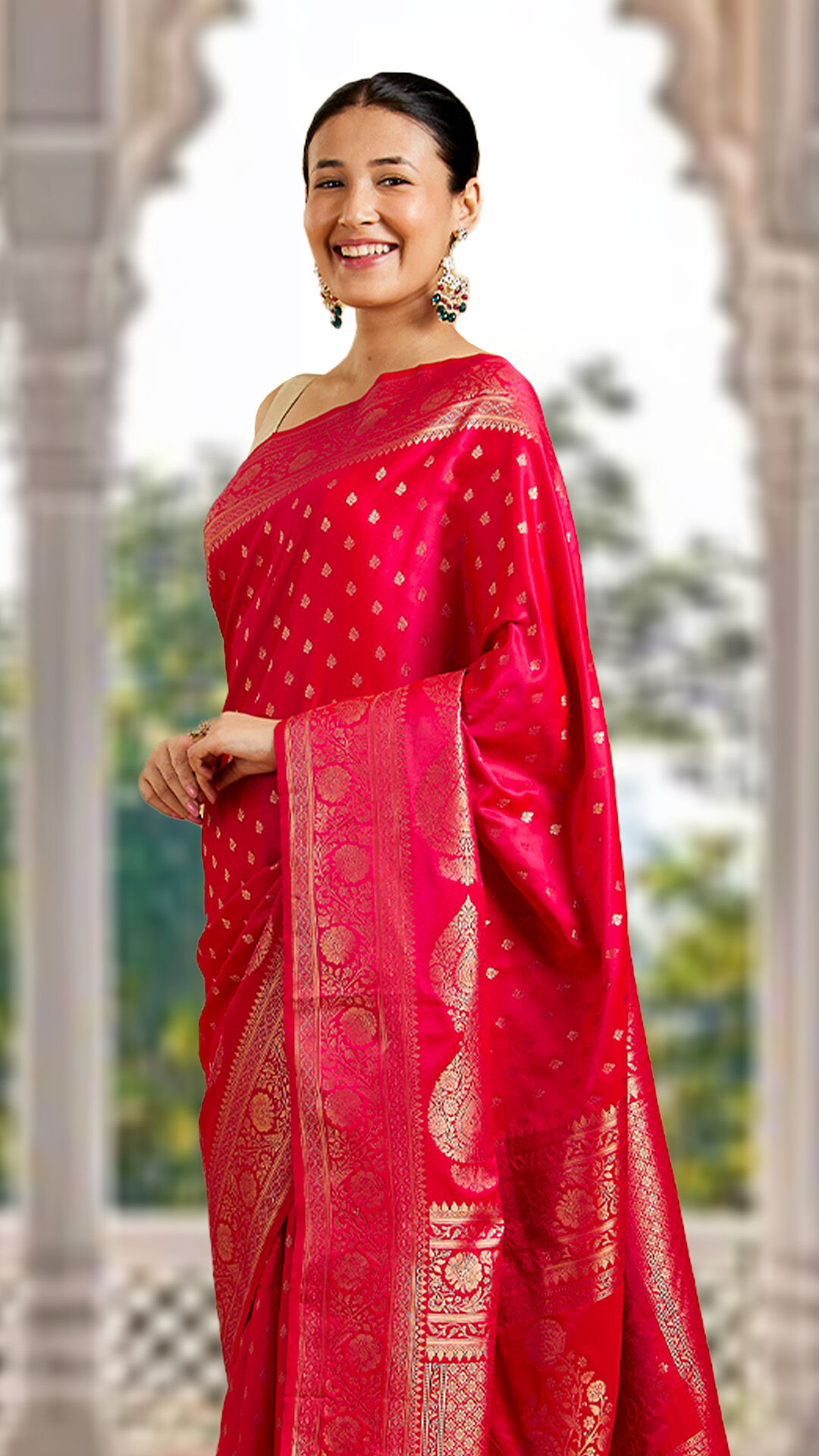STORIES BY MANYAVAR & MOHEY

Lifestyle
Cracking the Saree Code: A Beginner's Guide to Tying Silk Sarees
Date 10 March 2025 Reading time: 7-10 mins
So the big day's here and you've got that gorgeous silk saree pulled out... but now what? Draping a silk saree is an art, and we know you want to look no less than a masterpiece at that wedding! But don't worry, with our expert silk saree draping tips, you'll be arriving in ishtyle, with the saree sitting pretty, no matter how many thumkas you do on the dance floor!
The Importance of Silk Saree in Indian Culture
In India, the saree is more than just an outfit—it's an emotion, an identity, a cultural symbol handed down over generations. And when it comes to weddings and festivals, the silk saree collection reigns supreme. Be it a South Indian wedding with the bride resplendent in a heavy Kanjeevaram or a Bengali beauty in her treasured Tant, silk sarees are an integral part of our celebrations.
But it's not just about tradition. Silk sarees, with their rich lustre, exquisite weaves, and vibrant hues, have a timeless elegance that transcends trends. From classic Banarasis to trendy organza silks, there's a silk saree for every occasion and personal style. No wonder then that even in 2025, the love affair with silk sarees is still going strong!
Understanding the Basics of Saree Draping
Before exploring different saree tying methods, it's essential to master the fundamentals. A saree, usually 5-9 yards long, consists of three key elements:
- The Pleats: The front section, neatly folded and tucked into the petticoat or leggings
- The Pallu: The free end draped over the shoulder or styled in front
- The Fall: The lower portion that grazes the floor, shaping the saree’s elegant silhouette
Perfecting these elements is crucial for expert saree draping. Take your time, practice, and soon, you'll drape with confidence!
Silk Saree Draping Tips: A Comprehensive Guide
Choosing the Right Silk Saree for Draping
With so many silk sarees available, selecting the perfect one for an effortless drape can be challenging. Here are some silk saree draping tips to help you choose wisely:
- Consider the occasion: A lightweight Chanderi silk saree works well for a day function, while a heavy silk saree like Banarasi is perfect for an evening wedding.
- Think about the drape: Some silks, like Kanjeevarams, lend themselves better to classic drapes, while others, like organzas are more fluid and can be styled in contemporary ways.
- Factor in the work: A heavily embellished silk saree will need a simpler drape to let the work shine, while a plain silk can handle more intricate pleating and styling.
For festive sarees for weddings that tick all these boxes, check out Mohey's stunning range—from classic Banarasis to trendy prints, we've got you covered!
Step-by-Step Guide to Saree Tying Methods
Now that you’ve selected your saree, it’s time to perfect the drape. Follow this step-by-step guide to achieve an elegant and flawless look with ease.
- Start with a Well-Fitted Foundation: A well-fitted petticoat and blouse are crucial for expert saree draping. Your petticoat should sit snugly at your waist, providing the right support, while your blouse should be tailored to fit perfectly.
- Tuck the Saree Properly: Take one end of the saree and tuck it into your petticoat at the centre of your waist, ensuring it’s even. Leave about a metre of fabric hanging in the front for pleating.
- Create Neat Pleats: Gather the fabric in front and form evenly sized pleats, about 5-7 inches wide. Ensure all pleats are of the same size, neatly pressed, and aligned for a polished look.
- Secure the Pleats: Neatly tuck the pleats into the petticoat at your navel and secure them with a safety pin if needed to keep them in place.
- Drape the Pallu with Finesse: Wrap the remaining fabric around your waist, from left to right, and bring it over your left shoulder. For a contemporary touch, try an Indo-Western saree style with a belted or pre-stitched pallu.
- Adjust and Secure: Ensure the saree falls evenly, covering your legs properly. Use safety pins at the waist and shoulder for extra hold.
For more silk saree draping tips, practice different styles to find what suits you best and embrace the elegance of this timeless attire!
Expert Saree Draping Techniques for Different Styles
Mastering different saree tying methods can transform your look for any occasion. Here are seven iconic draping styles to try:
- Nivi Style: The most popular drape, originally from Andhra Pradesh, involves neatly pleated fabric tucked at the waist with the pallu draped over the left shoulder.
- Bengali Style: This elegant drape has no pleats; instead, the saree is wrapped around and the pallu is draped over both shoulders, often accessorised with keys or a brooch.
- Gujarati/Ulta Pallu Style: Conventionally worn for festive occasions, this drape brings the pallu from the back over the right shoulder, creating a front-facing pleat display.
- Maharashtrian Nauvari: A nine-yard saree is draped like a dhoti, offering a bold and regal look often seen in traditional Maharashtrian weddings.
- Tamil Madisar: Worn by Tamil Brahmin women, this style uses a nine-yard saree draped with a distinctive pleat at the back.
- Lehenga Style: This modern drape mimics a lehenga by tucking in pleats all around and letting the pallu flow gracefully.
- Indo-Western Style: For a contemporary twist, experiment with pre-stitched pleats, pant-style drapes, or belted pallus.
- Butterfly Style: Create a butterfly effect by pinning the pallu at the shoulder and fanning it out. Perfect for showing off a stunning border or pallu design.
- Mermaid Style: Pleat the saree all around the legs for a figure-hugging mermaid silhouette. This style is great for cocktail parties or sangeets.
- Mumtaz Style: Channel your inner retro diva with this '70s-inspired drape, where the saree is tied in front with a knot. Perfect for flaunting those abs!
For more silk saree draping tips and expert saree draping techniques, practice these styles and elevate your saree game. Whichever style you choose, remember—confidence is the best accessory!
Mastering the Art of Silk Saree Draping
Draping a silk saree is not just about following steps; it's about embracing your inner grace and femininity. It's about carrying forward a centuries-old tradition while putting your own spin on it.
For grand celebrations, explore Mohey’s embroidered sarees for special occasions that exude timeless beauty. You can also build your wedding trousseau by checking out our designer lehengas for brides and elegant gowns for weddings. Visit Mohey to find the perfect outfit for every special moment!
Jab Aap Taiyaar Hum Taiyaar!







